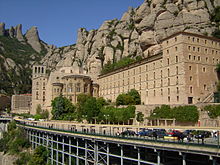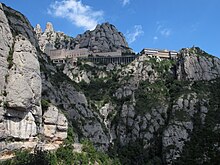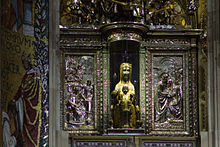Montserrat Monastery
The Benedictine Abbey of Santa Maria de Montserrat [ ˈsantə məˈɾi.a ðə munsəˈrat ] is located 721 meters above sea level in the mountains of the same name , about 40 km northwest of Barcelona in the extreme south of the Comarca Bages . Today about 80 monks live there according to the Regula Benedicti . In the monastery, the representation of Mary from the 12th century, " Our Lady of Montserrat ", popularly known as La Moreneta ("The Brown Woman "), is venerated by numerous pilgrims . As an important center of Catalan culture, Montserrat is of great symbolic importance beyond the Catholic Church .
getting there
Today, pilgrims often travel by bus, but above all with the Cremallera de Montserrat cog railway, which originally opened in 1892 and reopened in 2003 . A cable car was planned and built in 1930 by the Leipzig company Adolf Bleichert & Co. and its chief engineer Friedrich Gründel.
history
Under the abbot Oliba de Besalú , the monasteries of Santa Maria de Ripoll , Montserrat and Saint-Martin-du-Canigou were founded between 1025 and 1035 . As early as 1082, the Montserrat monastery became dependent on the Ripoll monastery. At the end of the 12th century, the number of monks on Montserrat was limited to twelve - just enough to continue to be considered an abbey. In 1409 and 1431, the monastery was restored to its independence through papal decrees. But after the union of Castile with Aragón through the marriage of the Catholic Monarchs in 1469 and the conquest of Granada (1492), Ferdinand II sent monks from Valladolid , so that the monastery was again controlled by others.
The late medieval monastery was destroyed by Napoleon's troops in 1809 and 1811 , and in 1835 it fell under the dismortment of the Spanish monasteries . In 1844 there was again independent monastic life in the old walls, which were largely renewed in the following years. The current monastery church was built by Leo XIII. in 1881 elevated to papal minor basilica .
During the last two decades of Franquism , the abbey provided a home to anti- Francoist groups. On December 12, 1970, 300 intellectuals gathered in the abbey who issued a manifesto calling for freedom for the opponents of General Franco convicted in the Burgos trials, as well as democratic rights and self-determination for the nationalities in the Spanish state.
architecture
Today's approx. 70 meters long and almost 30 meters wide monastery church has a single nave with side chapels and galleries above . The interior of the church is illuminated through round windows in the west and above the galleries as well as through a modern octagonal structure ( cimbori ) above the crossing . The central nave and side chapels are spanned by colored ribbed vaults. While the nave shows a mixture of neo-Romanesque and neo-Gothic style elements, there are also neo-baroque details in the choir area .
The organ in the monastery church was built in 2009 by the organ building company Blancafort Orgueners (Montserrat). The instrument is on the left side of the sanctuary; it hangs in an arched niche. In contrast to the baroque church furnishings , the prospectus has a modern design and shows the classic factory structure. The instrument has 63 registers (4,242 pipes ) on four manual works and a pedal . The Rückpositiv is swellable. The key action is mechanical, the key action electrically. There is a second purely electric gaming table in the presbytery.
|
|
|
|
|
||||||||||||||||||||||||||||||||||||||||||||||||||||||||||||||||||||||||||||||||||||||||||||||||||||||||||||||||||||||||||||||||||||||||||||||||||||||||||||||||||||||||||||||||||||||||||||||||||||||||||||||||||||||||||||||||||
- Coupling : I / I (sub and super octave coupling), I / II, II / II (sub and super octave coupling), III / I, III / II, III / III (sub and super octave coupling), IV / II, I / P, II / P, III / P, IV / P
- Remarks:
- (B) = bass side (left hand)
- (D) = treble side (right hand)
Madonna figure
The Black Madonna of Our Lady of Montserrat ( Mare de Déu de Montserrat or La Moreneta for short ) is the patron saint of Catalonia and is located in the apse of the monastery. The figure of Mary that is venerated today is a Romanesque statuette from the 12th century; with the blessing and crowned baby Jesus on her lap, she embodies the Sedes sapientiae type . As a sign of their power and dignity, they both hold an orb in their hand. Two silver reliefs on the side show the birth of Christ and the Visitation of the Virgin .
Biblicum Museum and Scriptorium Biblicum et Orientale
The monastery houses a museum with objects related to the archeology of the Holy Land , precious liturgical objects, paintings, etc. a. by El Greco , Caravaggio , Luca Giordano and Tiepolo , Claude Monet , Edgar Degas , Pablo Picasso , Ramon Casas i Carbó and Salvador Dalí .
The library of the Scriptorium Biblicum et Orientale has over 200,000 manuscripts and prints, including a papyrus collection with over 1,700 fragments. The “ Llibre Vermell de Montserrat ”, a collection of medieval songs from 1399, contains sacred pieces and secular Catalan songs with notes.
Boys' choir
In the church sounds daily at 13 o'clock the Marienlied Virolai that of the de Escolania Montserrat is sung, a boys' choir , which is documentary evidence since 1307 and is one of the oldest in Europe, flourished in the 17th and 18th centuries and to whom Josep Martí worked as a teacher.
meaning
In addition to its religious importance, the monastery is also considered a refuge of Catalan nationalism and Catalan culture . Since it was not subject to the bishops appointed by Franco even during the Franco dictatorship, thanks to the special ecclesiastical rights, masses were still celebrated in the forbidden Catalan language in the monastery .
Others
In Montserrat, St. Ignatius of Loyola resigned his officer rank in 1522, gave the Virgin Mary's dagger and sword and his fine clothes to a beggar . He put on the habit to consecrate himself to God. He later became the founder of the Societas Jesu , the Jesuit order .
In addition to the actual monastery, there are also numerous hermitages in the surrounding mountains, which can be reached from the monastery on well-maintained hiking trails. The hiking trails are classified according to duration and degree of difficulty and make Montserrat an interesting local recreation area for many residents of Barcelona.
On his second trip, Christopher Columbus named an island in the Lesser Antilles after the monastery, today's British colony of Montserrat .
Based on the miraculous image , 'Maria de Montserrat' is also a common Catalan birth name . 'Montserrat' is often used as a nickname (shortened to 'Montse'). For example, it was worn by the late sopranos Montserrat Caballé and Montserrat Figueras .
Abbots since the 19th century
- Miquel Muntadas, 1858-1885
- Josep Deàs, 1885–1921
- Antoni M. Marcet, 1921-1946
- Aureli M. Escarré, 1946-1966
- Gabriel M. Brasó (Abbot Coadjutor 1961–1966; 1966–1976 President of the Congregation of Subiaco)
- Cassià M. Just, 1966-1989
- Sebastià Bardolet, 1989-2000
- Josep M. Soler, 2000 – today
See also
literature
- Wilhelm von Humboldt : The Montserrat, bey Barcelona , to Goethe , August 1800. / As a book: The Montserrat near Barcelona. Berlin 1926.
- Fritz René Allemann, Xenia v. Bahder: Catalonia and Andorra. DuMont art travel guide. 4th edition. DuMont, Cologne 1986, ISBN 3-7701-1102-8 , p. 233, figs. 93-95.
Individual evidence
- ^ Anselm Maria Albareda : Història de Montserrat. L'Abadia de Montserrat, 2005, ISBN 8484157628 , p. 92.
- ↑ Birgit Aschmann : Adiós España. Catalan nationalism is a colorful phenomenon. In: Frankfurter Allgemeine Zeitung , December 14, 2014, p. 6.
- ↑ Information about the organ on the website of the builder company
Web links
- Abadia de Montserrat website (Catalan, Spanish, English)
- Scriptorium Biblicum et Orientale (English)
- Tourism site in Spain: the Monastery of Montserrat
Coordinates: 41 ° 35 ′ 36 " N , 1 ° 50 ′ 14" E






